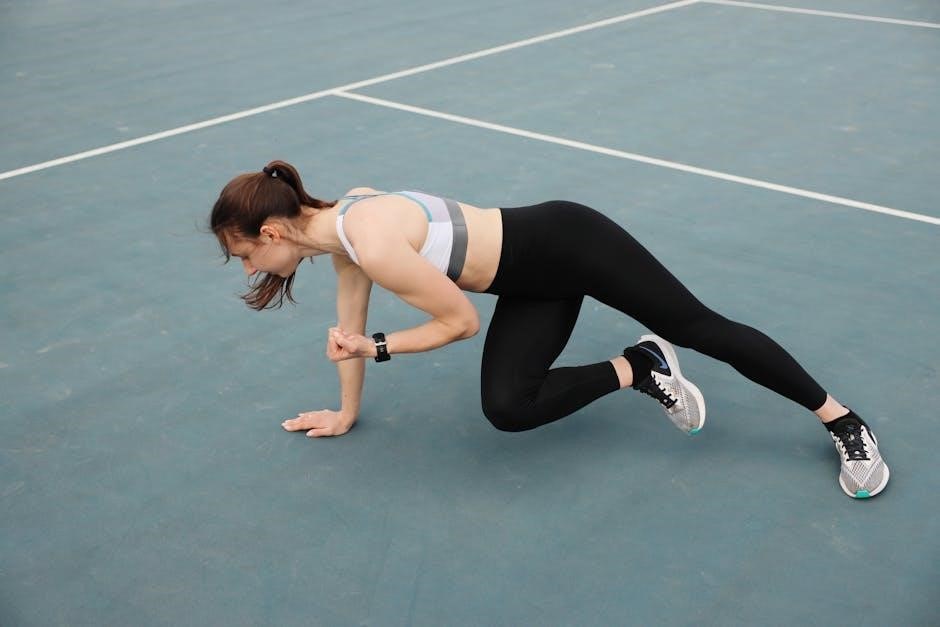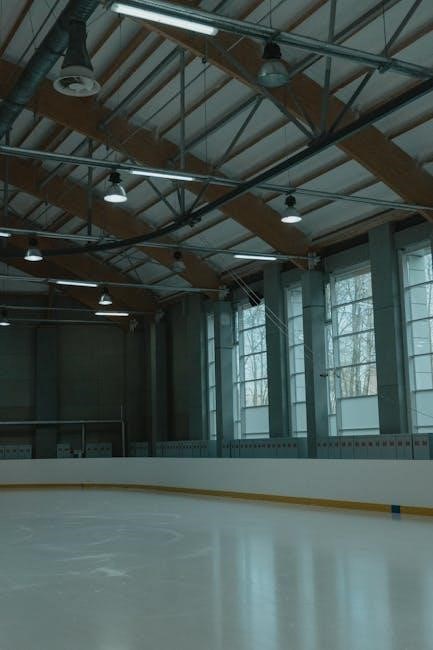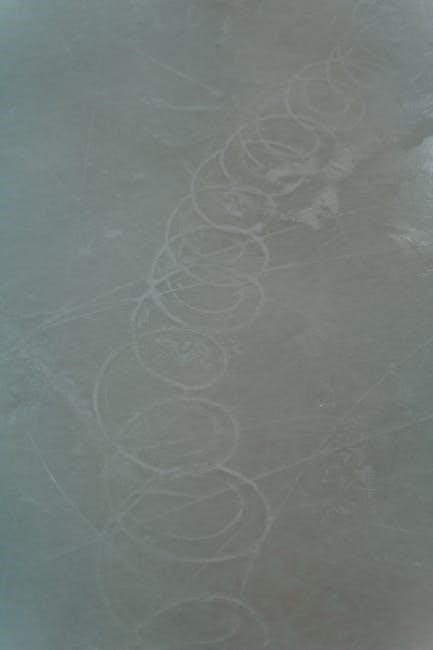Piriformis exercises are essential for relieving symptoms of piriformis syndrome‚ such as sciatica and buttock pain. These exercises combine stretching and strengthening techniques to improve muscle balance and flexibility. Regular practice can help alleviate discomfort and prevent future flare-ups‚ promoting overall hip and lower back health.

Causes and Symptoms of Piriformis Syndrome
Piriformis syndrome occurs when the piriformis muscle irritates or compresses the sciatic nerve‚ leading to pain and discomfort; The primary cause is often muscle tightness‚ spasms‚ or inflammation‚ which can result from prolonged sitting‚ repetitive movements‚ or physical activities that strain the hip region. Other factors include poor posture‚ overuse in sports‚ or even sudden awkward movements. The symptoms typically include sharp pain in the buttocks‚ which may radiate to the legs‚ resembling sciatica. Numbness‚ tingling‚ and tenderness in the affected area are also common. Pain often worsens with prolonged sitting‚ standing‚ or activities like walking or coughing. In some cases‚ individuals may experience difficulty sitting comfortably or performing daily tasks due to the discomfort. Early identification of these symptoms is crucial for effective management and rehabilitation. Addressing the root cause through targeted exercises and stretches can significantly alleviate symptoms and improve quality of life. Understanding the causes and recognizing the symptoms early is key to preventing further complications and promoting recovery.

Understanding the Piriformis Muscle
The piriformis muscle is a small‚ flat‚ pyramid-shaped muscle located deep within the buttocks‚ beneath the gluteus maximus. It plays a crucial role in hip movement and stability‚ connecting the base of the spine (sacrum) to the top of the thighbone (femur). Its primary function is to rotate the hip outward (external rotation) and stabilize the hip joint during activities like walking‚ running‚ and sitting. The piriformis muscle is also involved in maintaining proper posture and balance. Due to its proximity to the sciatic nerve‚ which runs alongside or even through the muscle in some individuals‚ tightness or spasms in the piriformis can compress the nerve‚ leading to pain and discomfort associated with piriformis syndrome. Understanding the anatomy and function of the piriformis muscle is essential for addressing related issues and developing effective exercises to improve its flexibility and strength. Proper care and targeted exercises can help maintain its health and prevent complications.

Benefits of Piriformis Exercises
Engaging in piriformis exercises offers numerous benefits‚ particularly for individuals experiencing piriformis syndrome or sciatica-related pain. These exercises help alleviate muscle tightness and reduce pressure on the sciatic nerve‚ providing relief from discomfort and numbness. Strengthening the piriformis muscle enhances hip stability and improves overall mobility‚ making daily activities like walking and sitting more comfortable; Stretching exercises‚ in particular‚ increase flexibility and reduce muscle spasms‚ while strengthening exercises promote better posture and balance. Regular practice can also prevent future flare-ups by maintaining muscle health and improving joint alignment. Additionally‚ piriformis exercises contribute to enhanced athletic performance by optimizing hip movement and reducing the risk of injury. Overall‚ incorporating these exercises into a fitness routine can significantly improve quality of life and support long-term musculoskeletal health. Consistency is key to achieving and maintaining these benefits‚ making piriformis exercises a valuable component of any wellness or rehabilitation program. By addressing both flexibility and strength‚ these exercises provide a comprehensive approach to managing piriformis-related issues and promoting overall well-being.

Stretching Exercises for Piriformis
Stretching exercises for the piriformis muscle are designed to relieve tension‚ improve flexibility‚ and reduce pain associated with piriformis syndrome. These exercises target the piriformis and surrounding muscles‚ promoting relaxation and better hip mobility. Regular stretching can help alleviate sciatica symptoms and enhance overall lower body flexibility.
Seated Piriformis Stretch
The seated piriformis stretch is an effective way to target the piriformis muscle while maintaining a comfortable position. To perform this exercise‚ sit on the floor with your left leg straight and your right leg bent‚ resting your right ankle on the outside of your left thigh. Grasp your right knee with your left hand and gently pull it toward your chest. You should feel a stretch in your buttocks and possibly along the outside of your hip. Hold this position for 20-30 seconds and repeat on the other side. This stretch helps relieve tension in the piriformis muscle‚ which can contribute to sciatica pain and hip stiffness. It is important to perform this stretch slowly and without bouncing to avoid further irritation. Regular practice of this exercise can improve hip mobility and reduce discomfort associated with piriformis syndrome.
Supine Piriformis Stretch
The supine piriformis stretch is a gentle and effective exercise to relieve tension in the piriformis muscle while lying on your back. To perform this stretch‚ lie on your back with both knees bent and your feet flat on the floor. Cross the ankle of your injured leg over the knee of your uninjured leg. Grasp the thigh of your uninjured leg and gently pull it toward your chest until you feel a stretch in the buttocks of your injured side. Hold this position for 20-30 seconds and repeat 2-3 times. This stretch helps alleviate sciatic pain and hip tightness caused by piriformis syndrome. It is important to keep the movement slow and controlled to avoid aggravating the muscle. If you experience pain beyond a 3/10 intensity‚ modify the stretch by reducing the pull on your thigh; Regular practice of this exercise can improve hip mobility and reduce discomfort associated with piriformis syndrome. For optimal results‚ combine this stretch with other exercises like the seated piriformis stretch and strengthening routines.

Strengthening Exercises for Piriformis
Strengthening exercises for the piriformis focus on improving muscle stability and hip function. The clam shell exercise‚ where you lie on your side and lift your top knee while keeping your feet together‚ is a key routine. These exercises enhance hip stability and prevent future discomfort.
Clam Shell Exercise
The clam shell exercise is a highly effective strengthening routine for the piriformis muscle. To perform this exercise‚ lie on your side with your legs bent and feet touching. Slowly lift your top knee upward while keeping your feet together‚ forming a “clam shell” shape. Hold for a few seconds‚ then lower your knee back down. Aim for 3 sets of 10-15 repetitions on each side.
Focus on controlled movements to avoid using momentum‚ ensuring the piriformis muscle engages properly. You should feel mild tension in your buttocks during the lift. For added resistance‚ a resistance band can be placed around the thighs just above the knees.
Regular practice of the clam shell exercise helps improve hip stability and strengthens the piriformis muscle‚ reducing the risk of injury or discomfort. It is particularly beneficial for individuals with piriformis syndrome or those seeking to enhance lower body strength and mobility;
Beginners can start without resistance and gradually incorporate bands as their strength improves. Proper form is essential to maximize benefits and prevent strain. This exercise is a cornerstone of piriformis rehabilitation and maintenance programs.

Preventing Piriformis Syndrome Flare-Ups
Preventing piriformis syndrome flare-ups requires a combination of consistent exercise‚ proper posture‚ and lifestyle adjustments. Regular stretching and strengthening exercises‚ such as the piriformis stretch and clam shell exercise‚ are crucial to maintain muscle flexibility and strength. Avoiding prolonged sitting or standing in one position can also help reduce pressure on the piriformis muscle.
Incorporating low-impact activities‚ such as swimming or cycling‚ into your routine can improve hip mobility without overstraining the muscle. Maintaining a healthy weight and ensuring proper ergonomics during daily activities can further reduce the risk of flare-ups. Additionally‚ avoiding repetitive movements that strain the hip and buttock area is essential.
For individuals with a history of piriformis syndrome‚ regular exercise programs should be continued to prevent recurrence. Taking short breaks to stretch and move during long periods of inactivity‚ such as during travel or desk work‚ can also help manage symptoms. By adopting these preventive measures‚ individuals can effectively reduce the likelihood of piriformis syndrome flare-ups and maintain long-term hip and lower back health.
Regular practice of exercises like the seated piriformis stretch‚ supine piriformis stretch‚ and clam shell exercise can significantly reduce muscle tension and strengthen the piriformis muscle. Consistency is key to achieving long-term relief and preventing future flare-ups.
Additionally‚ adopting proper posture‚ avoiding prolonged sitting‚ and engaging in low-impact activities can further support muscle health. It is essential to maintain a routine and consult with a healthcare professional to tailor exercises to individual needs.
By following these guidelines and staying committed to a structured exercise program‚ individuals can effectively manage piriformis syndrome and enjoy improved physical comfort and mobility in their daily lives.
